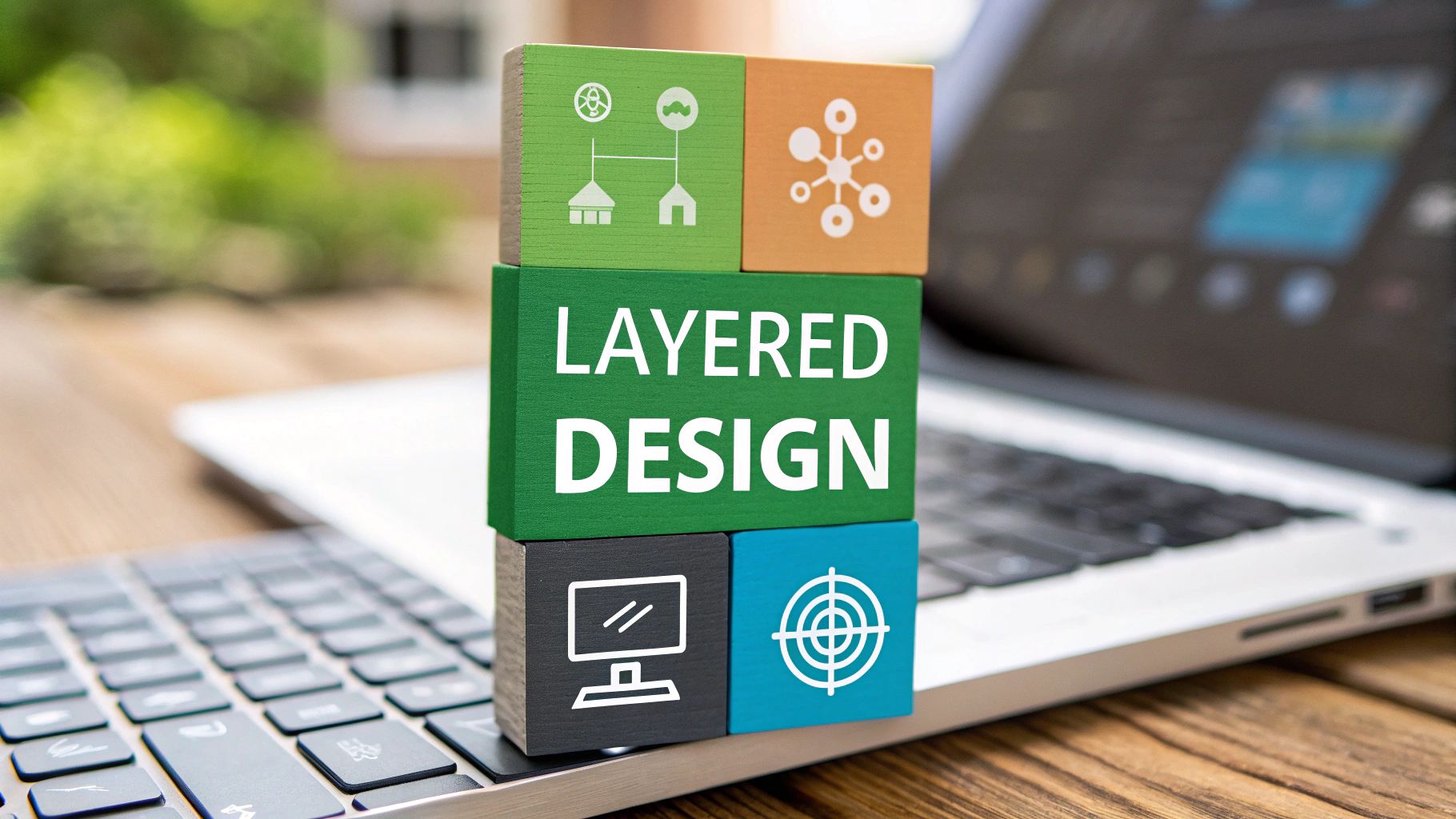Master battle-tested software design principles that drive successful application development. Learn practical strategies from industry veterans and discover how to create maintainable, scalable software that users love.

The way we think about software design has changed dramatically since the early days of programming. Back then, coding was seen more as an artistic pursuit, with developers relying mainly on intuition and improvisation. While this worked fine for small projects, it became clear that larger systems needed a more disciplined approach.
The software crisis of the 1960s and 70s brought these challenges into sharp focus. Projects routinely went over budget and deadlines, producing unreliable code that was hard to maintain. This led to the birth of software engineering as a formal discipline, bringing structure and methodology to what was previously a largely informal process. For instance, pioneers like Edsger Dijkstra, Frederick Brooks, and Donald Knuth helped establish key principles that shaped the field.
The first major shift came with structured programming, which introduced clear rules for organizing code. One notable change was moving away from the “goto” statement, which often created confusing “spaghetti code,” in favor of more organized constructs like loops and if-statements. This focus on structure naturally paved the way for the next big advancement in software design.
Object-oriented programming (OOP) brought a fundamental change in how developers approached software design. Its core concepts - encapsulation, inheritance, and polymorphism - gave developers powerful tools to build complex systems from smaller, self-contained pieces. This meant code could be reused more easily and changes in one area were less likely to break things elsewhere.
However, developers soon realized that just using OOP wasn’t enough to guarantee good design. Experience showed they needed higher-level principles to guide them in using these tools effectively.
This need led to the creation of the SOLID principles: Single Responsibility, Open/Closed, Liskov Substitution, Interface Segregation, and Dependency Inversion. These guidelines help developers create software that’s easier to maintain and adapt over time. The rise of agile development has also shaped modern design thinking, emphasizing quick iterations and close work with users.
Today’s software design principles continue to evolve as new technologies emerge. Each advance builds on past lessons while addressing new challenges in building reliable, maintainable software systems.

Software design patterns are practical solutions that can dramatically improve how development teams build software. While these patterns offer proven approaches to common programming challenges, many teams struggle to apply them effectively. Studies show that only about 50% of developers currently use design patterns successfully - indicating significant room for improvement in how teams implement these valuable tools.
Strong development teams rely on design patterns as foundational building blocks for their projects. For example, teams commonly use the Observer pattern when building event-driven systems that need to respond to user actions or system changes. The Factory pattern helps teams create objects cleanly without exposing internal creation logic. But success requires choosing patterns that truly fit the problem - forcing patterns into the wrong situations often backfires by adding unnecessary complexity. You can learn more about selecting appropriate patterns in this comprehensive design pattern guide.
To choose design patterns effectively, teams should follow a clear evaluation process:
Many successful organizations use structured frameworks to guide pattern usage:
To use design patterns successfully, teams should:
When teams master core design patterns and apply them thoughtfully, they build better software more efficiently. The key is focusing on patterns that truly solve problems rather than adding unnecessary complexity. This practical approach helps teams create maintainable code while keeping development costs in check.

The most successful software products focus on one key factor: the user experience. At the heart of this approach is user-centric design - a methodology that puts users’ needs first in every development decision. When done right, this approach leads to higher adoption rates and significantly lower support costs, especially for SaaS products.
Great software needs both a solid technical foundation and an interface that makes sense to users. This balance matters because according to recent studies, 91% of enterprise software errors come from how people use the software, not from bugs in the code. Even more telling, 49% of U.S. workers say they’ve considered quitting their jobs due to frustrating software tools. Read the full research here.
Getting real feedback from users is essential for making software better. Here are the main ways to collect it:
To keep improving, you need to measure how happy users are with your software. These are the most effective methods:
The real challenge is turning user feedback into better software. Success comes from picking changes that will help the most users and can be done well with available resources. Each update should have clear goals that directly address user needs.
When teams put users first in software development, everyone wins. The software becomes easier to use, more people adopt it, and fewer mistakes happen. This practical approach helps create software that users actually enjoy using every day. For more tips on building better software, check out DocuWriter.ai.

Software design keeps changing as new technologies emerge. Developers must adapt core design principles to handle modern requirements while building reliable applications. For instance, the growth of cloud platforms has pushed developers to rethink how they approach scalability and data storage.
The move to cloud systems and microservices has changed how we use traditional software design concepts. Modularity and loose coupling have become essential as applications grow more distributed. At the same time, serverless computing brings unique challenges around managing application state and dependencies. Building modern software requires deep knowledge of these platforms and their constraints.
Programming languages continue to shape how we design software. The rise of functional programming has influenced code structure and data handling approaches. Meanwhile, async programming patterns are changing how we deal with concurrency and errors. This shows the close connection between design choices and available tools. Looking back, we’ve seen many shifts like this before - from early languages like COBOL in the 1960s to JavaScript and the web in the 1990s.
Adding new technologies requires careful planning. Each new tool or platform needs evaluation based on specific project needs. A new database might improve speed but require major code changes. Similarly, integrating external APIs can add features but also introduce security risks.
As technology stacks grow, maintaining code quality becomes critical. Following established principles like SOLID (Single Responsibility, Open/Closed, Liskov Substitution, Interface Segregation, and Dependency Inversion) helps keep code maintainable during updates. Tools like DocuWriter.ai can help by automatically generating clear documentation as systems evolve.
Leading teams find ways to adopt new tech while keeping systems stable. They often start with small test projects before wider rollouts. This measured approach lets developers learn new tools safely. Strong testing and monitoring help catch issues early when adding new components.
By carefully choosing technologies, following proven design principles, and focusing on code quality, teams can build software that stays relevant as technology advances. This balanced approach helps organizations use new capabilities while avoiding common pitfalls and keeping codebases manageable.
Software teams today face a key challenge: delivering quality code quickly while maintaining good design principles. Working with agile methodologies requires teams to deliver business value early and adapt to changing requirements. However, this speed can sometimes compromise design quality and increase maintenance costs - which typically consume 60% of a software project’s budget. Finding the right balance is essential. Learn more about agile software development approaches.
Good design takes deliberate effort, even in fast-moving agile projects. Here are proven ways to maintain quality while moving quickly:
Quick delivery often creates technical debt that teams need to handle carefully:
Teams need clear ways to measure and track design quality. Here’s a practical framework:
These metrics give teams concrete data to guide improvements.
Building better software means constantly looking for ways to improve:
Software design principles build on core fundamentals but must adapt as technology advances. Today’s developers and architects need to stay current with how tools like AI and cloud platforms are changing established practices. This ongoing evolution requires a balance between proven methods and new approaches.
AI is reshaping how we approach software design through automated code generation and testing capabilities. This shift requires developers to strengthen their skills in algorithmic thinking and data handling. The widespread adoption of cloud computing has made principles like modularity and loose coupling essential, especially for distributed systems that need to scale.
Serverless architectures introduce unique challenges around managing state and dependencies. Software teams must rethink how they handle resource allocation and error management compared to traditional monolithic apps. Teams that understand these technical demands can better adapt their design processes for modern infrastructure.
Core design principles like SOLID remain fundamental even as technology evolves. These guidelines continue to promote code that’s easy to maintain and modify. However, their application needs careful consideration with new platforms and tools. For example, dependency injection becomes critical in microservices to handle complex relationships between components. The single responsibility principle helps create focused, reliable services that can scale independently.